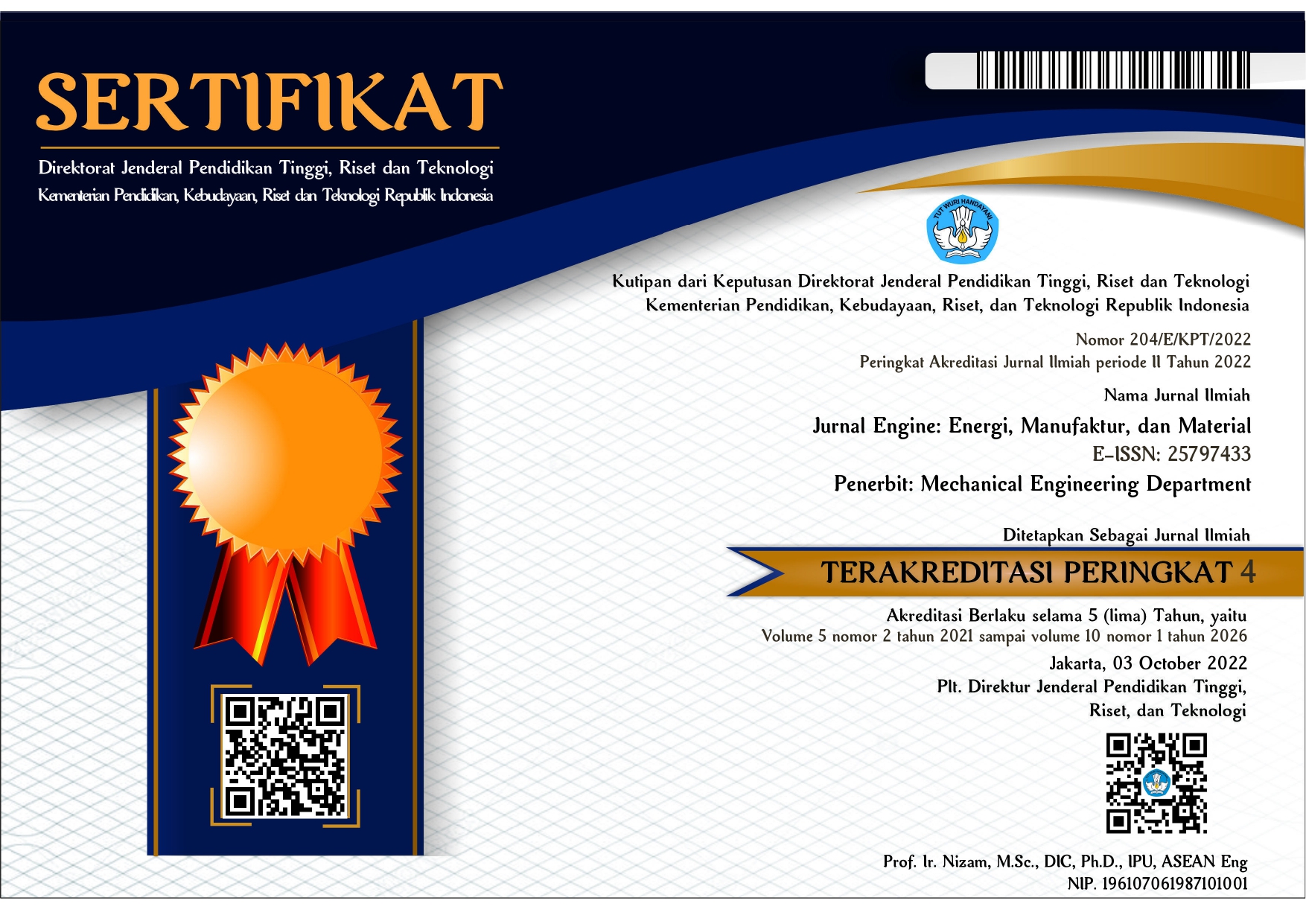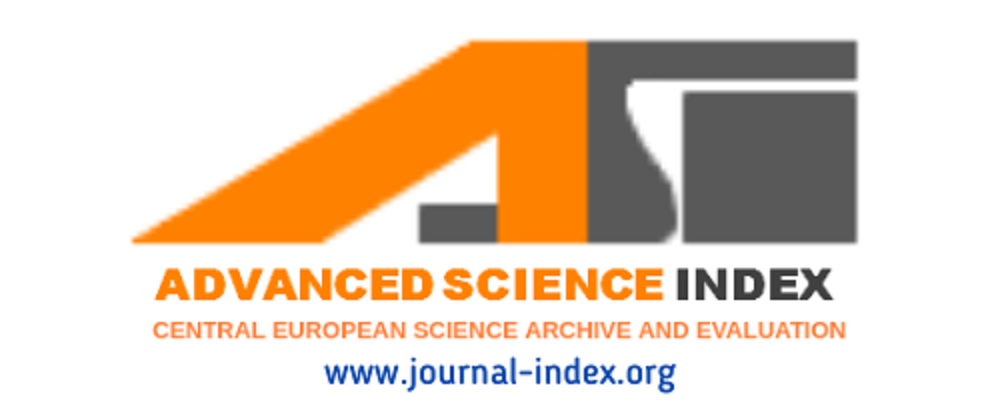Pembuatan Ekstrak Rhizophora mucronata Sebagai Bahan Baku Inhibitor Korosi Skala Lab dan Skala Aplikasi
(1) Politeknik Negeri Samarinda
(2) Babes Litbang Ekosistem Hutan Dipterokarpa
(3) Politeknik Negeri Samarinda
(*) Corresponding Author
Abstract
Keywords
Full Text:
PDFReferences
Afanasyev, I., Orlova, E., & Feoktistov, D. (2015). Evaporation of Stationary Alcohol Layer in Minichannel Under Air Flow. EPJ Web of Conferences. 82. Doi: 10.1051/epjconf/20158201054.
Al-Qudah, M. A. (2011). Inhibition of copper corrosion by flavonoids in nitric acid. E-Journal of Chemistry, 8(1), 326–332. https://doi.org/10.1155/2011/543498.
Bahrin, N., N. Muhammad, N. Abdullah, B. Hj. A. Talip, S. Jusoh, & S. W. Theng. (2018). Effect of Processing Temperature on Antioxidant Activity of Ficus carica Leaves Extract. Journal of Science and technology. 10 (2), pp. 99-103.
Chigondo, M., & F. Chigondo. (2016). Recent Natural Corrosion Inhibitors for Mild Stell: An Overview. Journal of Chemistry. Doi: 10.1155/2016/6208937.
Gurrala, P., K. Katre, P., Balusamy, S., Banerjee, S., & Sahu, K. C. (2019). Evaporation of Ethanol-water Droplet at Different Substrate temperatures and Compositions. International Journal of Heat and Mass Transfer. 145. Doi: 10.1016/j.ijheatmasstransfer.2019.118770
Horvath, Z. H. (2016). The effect of Storage on the Colour of Paprika Powders with Added Oleoresin. Acta Univ. sapientiae Alimentaria, 9, pp. 50-59.
Ikeuba, A. I., Ita, B. I., Etiuma, R. A., Bassey, V. M., Ugi, B. U., Kporokpo, E. B., & Chemistry, A. (2015). Green Corrosion Inhibitors for Mild Steel in H 2 SO 4 Solution : Flavonoids of Gongronema latifolium. Chemical and Process Engineering Research, 34, 1–10.
Innocenzi, P., Malfatti, L., Costacurta, S., & Kidchob, T. (2008). Evaporation of Ethanol and Ethanol-Water Mixtures Studied by Time-resolved Infrared Spectroscopy. J. Phys. Chem. A. 112, pp. 6512-6516.
Keo, S., Meng, C., Oeung, S., Nov, V., Lon, S. A., Vichet, T., Va, T., Sourn, M., & Chea, S. (2017). Preliminary Phytochemical Screening of Selected Medicinal Plants of Cambodia. Asian Journal of Pharmacognosy; 1 (4), 16-23.
Kusmierek, E., & Chrzescijanska, E. (2015). Tannic acid as corrosion inhibitor for metals and alloys. Materials and Corrosion, 66(2), 169-174.https://doi.org/10.1002/maco.201307277.
Morguette, A. E. B., B. G., Bigotto, R. L., Varella, G. M., Andriani, L. F. A., Spoladori, P. M. L., Pereira, F. G., Andrare, C. A. C., Lancheros, C. V., Nakamura, N. S., Arakawa, M. L., Bruschi, J. C., Tomaz, A. A. S. G., Lonni, G., Kerbauy, E. R., Tavares, L. M., Yamauchi, & S. F. Y. Ogatta, (2019). Hydrogel Containing Oleoresin from Copaifera officinalis Presents Antibacterial Activity Against Streptococcus agalactiae. Frontiers in Microbiology, 10. doi: 10.3389/fmicb.2019.02806.
Oeung, S., Nov, V., Ung, H., Roum, K., Yin, V., & Keo, S. (2017). Phytochemical analysis of different extracts of leaves of Nicotiana tabacum L. of Cambodia. Asian Journal of Pharmacognosy Research. 1(3), pp 18-26.
Oh, W., & Kato, S. (2017). Study on the Effect of Evaporation and Condensation on the Underfloor Space of Japanese Detached House Using CFD Analysis. Energies. Doi: 10.3390/en10060789.
Ogunleye, O. O., A. O. Arinkoola, O. A. Eletta, O. O. Agbeda, Y. A.
Osho, A. F. Morakinyo, & J. O. Hamed. (2020). Green Corrosion Inhibition and Adsorption Characteristics of Luffa cylindrical Leaf Extract on Mild Steel in Hydrochloric Acid Environment. Heliyon. Doi: 10.1016/j.heliyon.2020.e03205.
Okafor, P. C., Ebiekpe, V. E., Azike, C. F., Egbung, G. E., Brisibe, E. A., & Ebenso, E. E. (2012). Inhibitory action of artemisia annua extracts and artemisinin on the corrosion of mild steel in HOsolution. International Journal of Corrosion, 2012. https://doi.org/10.1155/2012/768729.
Rani, B. E. A., & Basu, B. B. J. (2012). Green Inhibitors for Corrosion Protection of Metals and Alloys: an Overview. International Journal of Corrosion, doi: 10.1155/2012/380217.
Riquelme, N., & S.Matiacevich. (2017). Characterization and Evaluation of Some Properties of Oleoresin from Capsicum annuum var. cacho de cabra. Journal of Food, 15(3), pp. 344-351.
Salhi, A., Bouyanzer, A., Chetouani, A., El Ouariachi, E., Zarrouk, A., Hammouti, B.,desjobert, J.M., & Costa, J. (2017). Chemical Composotion, Antioxidant and Corrosion Activities of Mentha suaveolens, JMES, 8(5), pp. 1718-1728.
Sanni, O., O. S. I. Fayomi, & A. P. I. Popoola. (2019). Eco-friendly Inhibitors for Corrosion Protection of Stainless Stell: an Overview. International Conference on Engineering for Sustainable World. Doi: 10.1088/1742-6596/1378/4/042047.
Segura, L. I., V. O., Salvadori, & S. M. Goni. (2017). Characterization of Liquid food Colour from Digital Images. International Journal of Food Properties, 20, S1, pp. S467-S477.
Singh, A., Ebenso, E. E., & Quraishi, M. A. (2012). Corrosion inhibition of carbon steel in HCl solution by some plant extracts. International Journal of Corrosion, 2012. https://doi.org/10.1155/2012/897430.
Sun, C., Z. Wu, Z. Wang, & H. Zhang. (2015). Effect of Ethanol/water Solvent on Phenolic Profiles and Antioxidant Properties of Beijing Propolis Extracts. Evidence-Based Complementary and Alternative Medicine. Doi: 10.1155/2015/595393.
Surya, S., & Hari, N. (2017). Studies on preliminary phytochemical analysis of some true mangrove species in Kerala. International Journal of Research in Pharmacy and Pharmaceutical Sciences, 2(3), 15–17. http://www.pharmacyjournal.in/archives/2017/vol2/issue3/2-3-12.
DOI: https://doi.org/10.30588/jeemm.v5i1.777
Article Metrics
Abstract view : 517 timesPDF - 322 times
Refbacks
- There are currently no refbacks.
Copyright (c) 2021 Wajilan Wajilan, Andrian Fernandes, Arif Wahyudianto

This work is licensed under a Creative Commons Attribution 4.0 International License.

Jurnal Engine: Energi, Manufaktur, dan Material is licensed under a Creative Commons Attribution 4.0 International License.




.jpg)


















